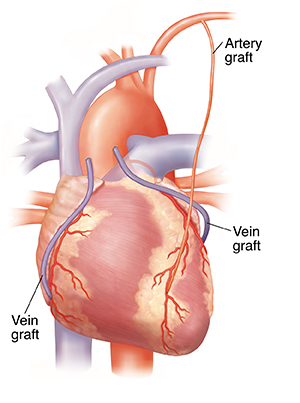Understanding Off-Pump Coronary Artery Bypass (CABG) Surgery
Coronary artery bypass surgery is a type of heart surgery. It’s often called CABG. The surgery is done to bypass a blocked area in a coronary artery or arteries. This is known as coronary artery disease. The coronary arteries are blood vessels that bring blood and oxygen to the heart muscle. They keep the heart muscle healthy so it can pump blood around the body.
What is off-pump CABG?
Off-pump heart surgery is done without using a heart-lung machine (called cardiopulmonary bypass). The heart instead continues to pump blood on its own during the surgery. This is also known as “beating heart surgery.”
During CABG, a surgeon takes an artery or a vein from another place in your body. It’s most often taken from the chest wall or a leg. This blood vessel is known as the graft. This is the “G” in CABG. That artery or vein is then attached above and below the blocked area of the coronary artery. This lets blood bypass the blocked area. It restores normal blood flow to the heart. Your healthcare provider may plan the surgery in advance. Or you might need it in an emergency if a vessel suddenly becomes blocked.

Why off-pump CABG is done
The surgery can help ease chest pain and the risk for a heart attack.
How off-pump CABG is done
Your procedure will be done by a cardiac surgeon. This is a doctor who treats diseases of the heart.. The surgery can be done in more than one way.
-
You’ll be given medicine to prevent pain. It will also put you to sleep during the surgery (general anesthesia). The anesthesiologist will watch your breathing and vital signs during the surgery. They will also give you blood-thinning medicine.
-
Your surgeon will make a cut (incision) to remove a blood vessel from another part of your body. This is the graft. The graft is most often taken from your chest wall or your leg.
-
Your doctor will make an incision down the middle of your chest. They will then separate your breastbone to reach your heart.
-
A device is placed on the heart to help keep stable the area being grafted. Your surgeon will attach one end of the graft to the diseased coronary artery beyond the blockage. This bypasses the blockage. The other end of the graft will be attached (stitched) to the aorta. This restores a flow of blood from the aorta through the graft to the heart muscle. The aorta is the main blood vessel leading from the heart out to the body.
Risks of off-pump CABG
All surgery has some risks. The risks of off-pump CABG include:
-
Infection
-
Bleeding
-
Irregular heart rhythms
-
Blood clots that can lead to stroke or heart attack
-
Problems from anesthesia
-
Kidney failure
-
Need for a procedure in the future to improve the heart’s blood supply
-
Heart attack
-
Grafts that don’t work correctly
-
Death
Your risks may vary according to your age, your general health, and other things. Talk with your healthcare provider about which risks apply most to you.
Online Medical Reviewer:
Mary Mancini MD
Online Medical Reviewer:
Ronald Karlin MD
Online Medical Reviewer:
Stacey Wojcik MBA BSN RN
Date Last Reviewed:
6/1/2022
© 2000-2025 The StayWell Company, LLC. All rights reserved. This information is not intended as a substitute for professional medical care. Always follow your healthcare professional's instructions.